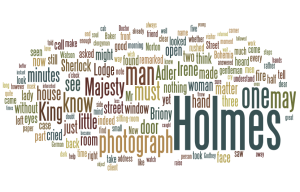Story: Scandal In Bohemia
Overall, I thought that the word cloud project was an interesting experience for sure. After listening to our guest speaker go over how the aesthetics of a data platform can truly effect how it’s absorbed by the audience, I was eager to delve into it. However, once I got into it I came to the conclusion that they aren’t really that informative. If you’ve already read the story, then of course it’s going to reinforce the common themes present in the readings! Despite my thoughts on this, I did like the design factor of the project and hope that we can do more of that this semester!
Here is my first word cloud, from Voyant. Overall, I thought that it turned out well. But the program was not very user-friendly. It appeared that it needed to be updated. I wasn’t sure if there was a way to change the colors, shapes, or alignment of the words because it was confusing to use. Also, the jargon used like “corpus” was outdated and I wasn’t sure what it even meant.
In terms of the words present, I wasn’t really surprised at all which were the most popular.I feel as if the largest word in all of our projects is going to be Holmes.
The same can be said for the following word cloud, from Wordle.
I really liked using this tool a lot more because it was very straight-forward. User friendly programs are a huge plus in a project like this! As I just said, the words that appeared didn’t really surprise me all that much, either. Both of my word clouds are pretty similar, I think. King and photograph are two of the larger words up there, and as we know from reading the story, those are two important themes.
In part of this assignment, we also had to read two articles. I thought that the second one was pretty comical, and at the same time, agreeable. Because I’m a journalism student, I saw exactly where the author was coming from in terms of how a word cloud sometimes doesn’t illustrate the substance of a story at all. In journalistic writing, we actually avoid using similar words if we possibly can, unless it is the proper title of document, a study, a group, the name of a person, etc. We try to use synonyms as much as we can to crack any monotony in the bud and make our writing more colorful and appealing. In short, there’s probably close to 10 different words that can be swapped out throughout a story that essentially mean the same thing.
“Prettiness is a bonus; if it obliterates the ability to read the story of the visualization, it’s not worth adding some wild new visualization style or strange interface.”
In fiction works, such as a Holmes story, I noticed that word clouds are totally useful in illustrating some of the main concepts that are present. I think that analyzing word usage this way definitely has its benefits, but the analysis can’t end there. One of the larger duties in analyzing text is being able to identify what these themes actually mean. I do not think, however, that word clouds can substitute the true analytical thinking needed to process what these themes mean in the grand scheme of the plot. The initial thought of the word clouds is cool, but I think that there may be better tools out there to successfully show the themes of the story that looks more into substance and not just the word count.

